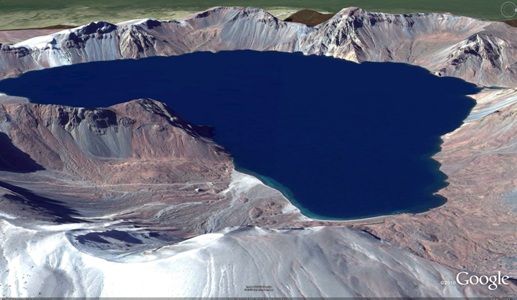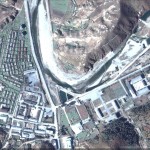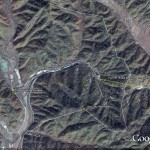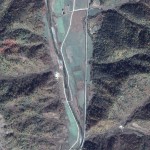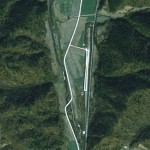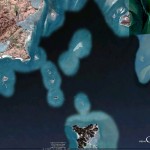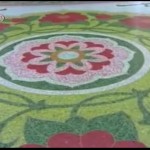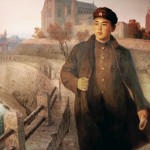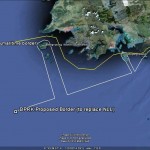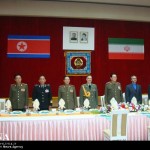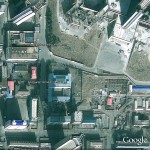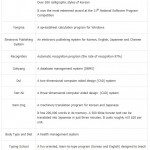Martyn Williams has created the most thorough information source of North Korean web pages of which I am aware.
Directory of North Korean web sites
December 12th, 2010New Google Earth Imagery: Paektusan, Taegwan, Kangryong
December 11th, 2010Google Earth has posted new high-resolution imagery of the DPRK. I have not finished going through all of it, but here are some special points of interest:
1. Here is a fantastic image of Lake Chon atop Mt. Paektu—now in high-resolution:
Click image for very large version of the picture.
In Google Earth’s 3-D environment it really is stunning (particularly if you have a large monitor). It is understandable why Kim Jong-il would like everyone to believe he was born here! Actually, his official birthplace is visible just south-east of the lake at 41.863137°, 128.159740°. His actual birthplace in Russia (48.737285°, 135.740998°) is still not available in high-resolution imagery.
2. Previously, I posted a story about a Myanmar military delegation visit to the DPRK. Among the many locations visited by the delegation were stops with a women’s artillery unit and KPA “Radar Factory” in Taegwan. Since Taegwan is now in high resolution, I have identified these locations (40.228782°, 125.237944°).
You can learn more about the military delegation here.
3. Taegwon is also home to a leadership train station for Kim Jong-il complete with security perimeter, tunnel exit, and underground storage facility (40.305198°, 125.205716°):
I have one minor quibble with the new imagery, and that is that I cannot access the “newer” (by date) low-resolution imagery that has been covered up by the “older” (by date) high-resolution imagery. For example, just south of the Taegwan leadership train station mentioned above it appears the DPRK has upgraded the roads and is in the process of building a new train station (or runway). I was able to go to Wikimapia and download the “old” image before it vanished down the memory hole. Below are the visuals I am discussing:
The image on the right, in low resolution, has been replaced by the older, high-resolution image on the left. As we can see from the image on the right, there is a new train station or runway in this location. The reason I am able to conclude that the picture on the right is newer (by date) is because the road has been upgraded. This means they are building up, rather than building down, the facility in question.
4. Kangryong county, which contains the peninsula and islands from which the DPRK shelled Yonpyong Island, are now all in high resolution on Google Earth. Check out how militarized these pieces of real estate are.
Friday Fun: “For the good of ladies”
December 10th, 20101. This first item is from the DPRK publication Korea Today—an article hilariously titled “For the Good of Ladies“:
For those who do not wish to visit the DPRK’s new Naenara webpage, I post the text below. The story perfectly demonstrates the fundamental problem with economic calculation in a socialist society (or the non-price political allocation of resources):
One summer day in 1979 the leader Kim Jong Il went to see the Pyongyang Maternity Hospital under construction. Looking up with great delight at the grand concrete skeleton of the building completed in a short span of time, he entered the central hall, when an official told him that they were going to lay only the ground, first and second floors with marble and the rest with scagliola because it would cost too much to lay all the floors with marble.
“What then do we use marble for? All the floors should be laid with marble,” said Kim Jong Il. After a while of deep thought, he proposed making a decorative floor of jewels, which are much better than marble. The officials were all amazed at his suggestion of using valuable natural jewels for the floor decoration.
Kim Jong Il reiterated his suggestion, saying they had better make a jewel floor by plastering the central hall, the main passage for all patients and visitors to the hospital, with a mixture of natural jewels.
This was how over 100 tons of natural jewels and colour stones were supplied to the project, and the floor of the central hall was studded with rubies, sapphires, topazes and other precious jewels, reminding one of a jewel carpet.
I have no idea how to build a hospital, but I am fairly confident that this was a poor suggestion.
UPDATE: here is the “jewel carpet”
2. The second item is some interesting video footage shot by a representative of the Czechoslovakian Embassy (1989/1990) and posted on YouTube. Check them all out here. Below area few select videos:
3. The third item is a new web page featuring selected pictures of Kim Jong–il’s guidance tours. Check out “Kim Jong–il looking at things“.
4. The Fourth item is a discussion that is part art and part propaganda. Is this Kim Jong–un or not?
38 North and Leonid Petrov offer some information.
UPDATE: it is not. The painting is of Kim Il-sung in Manchuria.
DPRK claims waters around Yonphyong Island
December 8th, 2010Pictured above (Google Earth): The NLL and the DPRK’s alternative maritime border in the West Sea
Evan Ramstad writes in the Wall Street Journal:
North Korea state media on Thursday issued a statement that claimed possession of all waters around South Korea-controlled Yeonpyeong Island, clarifying for the first time that its Nov. 23 attack of the island was motivated by a different view of the inter-Korean maritime boundary in the Yellow Sea than is widely held.
North Korea has said since the attack that it was motivated because shells from an artillery test South Korea conducted on the island that day fell into its waters.
Military officials in South Korea have said that its test-firing that day was routine and was directed into South Korean waters south of the island. South Korea has long understood the maritime boundary to be in several miles north of the island and, as a result, directs its tests southward.
But officials and analysts who have watched North Korea’s evolving statements since Nov. 23 have noticed that Pyongyang didn’t claim that South Korea fired northward, raising questions about just what territory North Korea was claiming.
The new statement carried by Korea Central News Agency wiped out the ambiguity.
“The above-said island is located deep inside the territorial waters of the DPRK side from the maritime demarcation line,” the statement said, using an acronym for North Korea’s full name, the Democratic People’s Republic of Korea.
“If any live shell firing is conducted from there, shells are bound to drop inside the territorial waters of the DPRK side no matter in which direction they are fired because of these geographical features of the island,” the statement added.
North Korea has long disputed the inter-Korean maritime border in the Yellow Sea, or West Sea, which was drawn up by the United Nations when hostilities in the Korean War ended with a ceasefire in 1953.
In recent years, North Korea has grown more vocal and belligerent in its claim of a different maritime border, one that runs many miles to the south of the one drawn by the U.N. and known in South Korea as the Northern Limit Line, or NLL.
In North Korea’s claim, five islands that have long been controlled by South Korea lie within its waters. However, North Korea has not claimed possession of the islands.
As it exists, the U.N.-drawn border forces military and fishing vessels from the North Korean city of Haeju and other points along its southern coast to make a coastline-hugging journey westward for 30 miles or more before they can reach open water.
Here is the DPRK’s statement in full from the new KCNA page (for those who do not want to visit the new page):
Pyongyang, December 9 (KCNA) — The Secretariat of the Committee for the Peaceful Reunification of Korea released a detailed report on Wednesday laying bare the truth and nature of the Yonphyong Island shelling incident in the West Sea of Korea. It clarified internally and externally who was the provocateur and who was to wholly blame for it.
The report said:
The Yonphyong Island covers just 6.8 square km and it has nearly 18 km in circumference. But this small island has been fortified as such core military stronghold that the puppet forces call it “area for top class guard.” A brigade of the puppet marine corps and “K-9” self-propelled artillery pieces of more than one company are deployed on the island and it has a dense network of detection means and intelligence-gathering and communication facilities.
It was waters not far from Yonphyong archipelago that patrol ship of the puppet forces “Cheonan” sank in March this year. The puppet warmongers have persistently escalated the tension in this area, crying out for seeking “revenge,” and at last went the lengths of perpetrating direct shelling under the pretext of a military exercise.
The motive of the incident and the background against which it occurred make it clearer that it was a deliberate provocation of the puppet forces.
The above-said island is located deep inside the territorial waters of the DPRK side from the maritime demarcation line. If any live shell firing is conducted from there, shells are bound to drop inside the territorial waters of the DPRK side no matter in which direction they are fired because of these geographical features of the island.
The puppet warmongers fired as many as thousands of shells into the territorial waters of the DPRK side after deliberately fixing those waters as a target of sighting firing. This reckless act was obviously a deliberate provocation to prompt the DPRK to take a military counter-action.
No matter what rhetoric the south Korean conservative group may use in a bid to shift the responsibility for the incident onto the DPRK like a thief crying “Stop the thief!” it cannot hide the truth.
The above-said incident was an inevitable product of the puppet conservative group′s vicious moves to escalate the confrontation with fellow countrymen and ignite a war.
The inter-Korean dialogues and visits which had been brisk since the adoption of the June 15 joint declaration were totally suspended and an atmosphere of reconciliation, unity and reunification rapidly got cool due to the puppet group.
The conservative authorities of south Korea have persistently mocked at the DPRK′s sincere efforts to improve the inter-Korean relations and turned away their faces from them.
Since the puppet warmongers′ seizure of power, they have staged an increasing number of exercises for a war of aggression against the DPRK and they assumed more dangerous nature.
They have staged more frequent military exercises in waters off Yonphyong Island, in particular.
When the puppet group′s all policies to escalate the confrontation with the DPRK and war moves against it proved totally bankrupt in face of the domestic and foreign public′s rebuff and condemnation, it orchestrated such hideous shocking incident as the Yonphyong Island shelling incident as its last-ditch effort.
While the conservative group of south Korea was the direct provocateur of the said incident, the U.S. was a wire-puller and chieftain of the incident as it egged the puppet warmongers onto the military provocation.
The above-said incident was triggered off because of the illegal “northern limit line” fixed by the U.S. in the West Sea of Korea.
Military clashes and disputes have not ceased in waters of the West Sea of Korea since the cease-fire due to this bogus line having no ground in the light of international law as it was unilaterally drawn by Clark, the then UN forces commander on August 30, 1953.
The U.S. sidestepped the DPRK′s fair and aboveboard proposal for fixing a military boundary line in the West Sea. And it instigated the puppet conservative group to totally scrap the June 15 joint declaration and the October 4 declaration, claiming that the setting up of a special zone for peace and cooperation in the West Sea would bring the “northern limit line” to naught.
The U.S. in league with the puppet warmongers have run the whole gamut of schemes to make the “northern limit line” an established fact at any cost.
Not only the warship “Cheonan” case in March but the recent Yonphyong Island shelling incident were cooked up according to this sinister scenario of the U.S. and under its backstage manipulation.
Since the above-said shelling incident the U.S. has massively supplied the latest weapons to the puppet group while zealously egging it onto carry out what it called “retaliation plan.” This fact goes to clearly prove that the U.S. was the arch criminal who orchestrated and wire-pulled the incident behind the scene.
Additional Information:
1. I have been keeping up with the Yonpyong shelling saga here.
2. Google Earth/Maps now has high resolution imagery of Yongpyong and the DPRK peninsula where the attack originated. Check it out at 37°39’44.04″N, 125°42’9.71″E and 37°46’21.28″N, 125°36’16.97″E
3. Sorry, Josh, no “Brigandish” this time. Josh Stanton (One Free Korea) gets credit for inventing the KCNA drinking game. Every time KCNA mentions “Brandish” behavior, you take a drink. For those who like to imbibe more frequently, here is a link to every single KCNA story that mentions “Briganish”–all 738 of them. This is courtesy of the indispensable STALIN search engine.
Read the full Wall Street Journal story here:
North Korea Claims Waters Around Shelled Island
Wall Street Journal
Evan Ramstad
12/8/2010
DPRK’s midget subs torpedo equipped
December 7th, 2010According to the Joong Ang Daily:
North Korea’s new midget submarines feature torpedo launch tubes, according to South Korean intelligence sources, suggesting that the North is planning more torpedo strikes.
According to sources, satellite imagery examined by South Korean and U.S. intelligence officials have shown 4-meter-long (13.1 feet) torpedo launch tubes attached to North Korea’s new line of “Daedong-B” minisubmarines. Intelligence authorities from both countries had suspected that satellite images showed launch tubes attached to the submersibles. An intelligence tip later confirmed that they were for lightweight torpedoes.
The Daedong-B model is said to be 17 meters long, 4 meters wide and 2.2 meters high. One special characteristic of the midget submarine, intelligence sources said, is the rear of the vessel, which is shaped like a ramp to easily enable agents to get on and off.
North Korea has also been holding exercises with the new submarines.
“Intense military exercises with the midget submarines were conducted by North Korea in July and recently while South Korean and U.S. troops were holding joint exercises,” a South Korean intelligence official said, adding that the drills were aimed against South Korean vessels.
Based on the evidence, intelligence authorities believe North Korea is now capable of carrying out attacks with its minisubmarines, along with its Yono class submersibles, which the South Korean government believes the North used to sink the Cheonan in March.
North Korea has not made any direct threats to attack the South with its torpedoes since March, which it did on a regular basis before the sinking of the South Korean warship Cheonan.
However, North Korea’s preference for torpedoes is well-known, and they have been the weapons of choice for Kim Il Sung and Kim Jong-il.
In April 2007, North Korea’s state broadcaster Korean Central Television (KCTV) showed Kim Jong-il instructing marines in a military drill involving torpedoes. The “Dear Leader” was reported to have “laughed with vigor” and immensely approved the torpedo training. Kim was said to have mounted a torpedo-equipped submarine himself and “went out to the wild seas” with the seamen.
North Korean propaganda claims that its torpedo boats sunk the U.S.S. Baltimore in 1950, although the U.S. battleship was never deployed in the Korean War. On the day cited by North Korea for the attack, the U.S.S. Juneau and two British warships destroyed several North Korean torpedo boats escorting supply vessels without any significant return fire from the North Koreans.
I cannot find the actual satellite images mentioned in this story anywhere, so caveat emptor.
Read the full story here:
North’s new midget subs are torpedo equipped
Joong Ang Ilbo
Lee Young-jong, Christine Kim
12/7/2010
Iranian defector ‘saw North Korean technicians’ in Tehran
December 7th, 2010Image via Arms Control Wonk
According to AFP (via Zawya):
A former Iranian diplomat who defected to the West said on Tuesday that he had regularly seen North Korean technicians at Tehran airport between 2002 and 2007.
Western intelligence agencies suspect North Korea may be helping Iran to develop long-range ballistic missiles and nuclear weapons technology. Tehran insists it simply wants to develop civilian nuclear power.
Mohammed Reza Heydari, Iran’s former consul in Norway, sought political asylum in December amid protests in his homeland in the aftermath of Iranian President Mahmoud Ahmadinejad’s disputed re-election.
On Tuesday he told reporters at a meeting organised by the Paris-based think tank the Centre of Political and Foreign Affairs that he had seen North Koreans when he had been a foreign ministry official at Tehran airport.
“I saw them with my own eyes,” he said. “They were treated in a very discreet manner, in order to pass through without being seen.”
Heydari said he was “100 percent certain” that these contacts continue and alleged he had spoken to members of Iran’s hardline Revolutionary Guards Corps who confirmed that Iran plans to build a bomb.
“I was able to confirm that Iran has two goals — to develop the range of its ground-to-ground missiles and to obtain a nuclear weapon with the help of North Korea,” he said.
Since defecting, Heydari has sought to convince more Iranian diplomats to abandon the regime and form an opposition movement in exile.
Describing his view of the political scene back in Tehran, Heydari said a group of conservatives around the speaker of parliament Ali Larijani were increasingly opposed to a more religious faction backing Ahmadinejad.
According to the defector, while Larijani’s group wants to govern Iran, Ahmadinejad’s supporters have a more “global agenda” and are awaiting the return of the “hidden imam”.
Some Shiite Muslims believe that the 12th Imam, known as the Mahdi, who disappeared in the year 874, will return to bring justice to the world.
Heydari said Ahmadinejad’s faction is pushing Iran’s nuclear agenda. “According to our information, this inner circle believes that with only two bombs they can ensure the survival of the country and of Islam,” he said.
The usual defector caveats apply. According to Bob Baer, Iran’s nuclear program has been an intelligence black hole. Of course so was the DPRK’s—and they managed to surprise everyone by bulding a LEU facility right in the middle of Yongbyon. There is no shortage of evidence that the two countries are working together on a number of political, economic, and military initiatives, however, so it is entirely possible that this Iranian defector is telling the truth.
As an aside, many Americans are nervous about visiting both Iran and the DPRK, but having visited nearly 45 countries, I can tell you that Iran and the DPRK are in the top three for me. Of course, I live on the beach and prefer to “rough it” on vacation.
Read the full story here:
Iranian defector ‘saw North Korean technicians’ in Tehran
AFP (via Zawya)
12/7/2010
Three new books on the DPRK
December 7th, 2010
Book 1: Europe – North Korea: Between Humanitarism and Business?
Myungkyu Park (Ed.), Bernhard Seliger (Ed.), SungJo Park (Ed.)
This book is not yet available at the US Amazon web page but it is available (in English) at the German Amazon web page. Here is a chapter outline of the book (PDF) from GPI’s Paul Tija, who is a contributor.
Book 2: Korean War in Color: A Correspondent’s Retrospective on a Forgotten War
John Rich (Author), Lee Jin-hyuk (Editor)
Order at Amazon
Book 3: North Korea Caught in Time: Images of War and Reconstruction
Chris Springer
Order at Amazon
The latter two books are picture albums. Here is a review of them both by Michael Rank.
List(s) of other North Korea books and films can be found here.
No yachts for you (UPDATE)
December 7th, 2010UPDATE (12/7/2010): Austrian convicted for yacht sale to DPRK. According to Reuters:
A Vienna court has fined an Austrian man 3.3 million euros ($4.4 million) over the sale of luxury goods, including yachts, believed destined for North Korean leader Kim Jong-Il, a court official said Tuesday.
The businessman, who was not named, was also handed a nine-month suspended sentence late Monday for the dealings which violate an international trade embargo against Kim’s impoverished state, court official Christian Gneist said.
“The amount was 3.3 million euros because this was the amount he received as payment,” Gneist said. The trade violated U.N. sanctions against North Korea imposed over its nuclear bomb tests.
Working with a North Korean intermediary close to Kim, the Viennese man tried to procure two yachts and received payment for them, Gneist said.
Prosecutors also accused him of lining up eight top-end Mercedes-Benz S-Class cars and musical instruments including a Steinway grand piano for Pyongyang, Austrian daily Kurier reported.
The Austrian man pleaded guilty and told the court he had not realized what he was getting into, Kurier said.
“It doesn’t have anything to do with atomic bombs. I am not interested in politics. I am a businessman,” the paper quoted him as telling the court.
Italian financial police helped to break up the sale of the yachts last year, which prosecutors believed to be a birthday present for Kim. The Austrian bought them from the Azimut-Benetti boatyard, one of the world’s leading yachtmakers. Azimut-Benetti was not accused of wrongdoing and had cooperated fully in the investigation, Italian police have said.
The sale of luxury goods to North Korea is banned under a U.N. resolution in retaliation for the country’s nuclear testing program. The U.N. Security Council unanimously voted to widen its sanctions after North Korea’s nuclear test in May last year.
ORIGINAL POST (7/23/2009): According to Reuters (via Washington Post), UN sanctions have prevented the sale of two Italian yachts to the DPRK. To top it off, the DPRK purchaser lost the deposit! According to the article:
Financial police in the city of Lucca in central Italy said the vessels were worth nearly 13 million euros ($18 million) and had been purchased by an Austrian intermediary from the Azimut-Benetti boatyard, one of the world’s leading yachtmakers.
The Austrian intermediary then ceded the contract to a Chinese company, which in turn paid a Hong Kong business to take delivery of the vessels, police said.
“The difficulty was tracing it back to a violation of the sanctions,” said Colonel Antonio Leone, the Finance Police’s commander in Lucca. Asked if Kim was the intended final recipient of the vessels, he said: “It is an irrefutable fact.”
“There has been a thorough investigation, partly in Austria, backed up by confessions and investigative breakthroughs.”
The yachts were initially confiscated by Italy’s Economic Development Ministry but have since been returned to the boatyard, which has been allowed to keep the deposit.
Azimut-Benetti is not accused of wrongdoing and has cooperated fully in the investigation, police said.
The sale of luxury goods to North Korea is banned under a U.N. resolution in retaliation for the country’s nuclear testing program. The U.N. Security Council unanimously voted to widen its sanctions after North Korea’s May 25 nuclear test.
Given the complex chain of front companies involved in carrying out this transaction, the application of the UNSC resolution is a great illustration of what Haggard and Noland call “whac a mole“. The North Koreans will now attempt to reconstitute their trade and proliferation networks using new front companies. According to Haggard and Noland:
As a small country dependent on foreign trade and investment, North Korea should be highly vulnerable to external economic pressure. In June 2009, following North Korea’s second nuclear test, the UN Security Council passed Resolution 1874, broadening existing economic sanctions and tightening their enforcement. However, an unintended consequence of the nuclear crisis has been to push North Korea into closer economic relations with China and other trading partners that show little interest in cooperating with international efforts to pressure North Korea, let alone in supporting sanctions. North Korea appears to have rearranged its external economic relations to reduce any impact that traditional sanctions could have.
Given the extremely high priority the North Korean regime places on its military capacity, it is unlikely that the pressure the world can bring to bear on North Korea will be sufficient to induce the country to surrender its nuclear weapons. The promise of lifting existing sanctions may provide one incentive for a successor government to reassess the country’s military and diplomatic positions, but sanctions alone are unlikely to have a strong effect in the short run. Yet the United States and other countries can still exercise some leverage if they aggressively pursue North Korea’s international financial intermediaries as they have done at times in the past.
Read Haggard’s and Noland’s complete analysis here.
Read the full stories here:
Italy blocks sale of yachts to North Korea’s Kim
Reuters (via Washington Post)
7/23/2009
Sanctioning North Korea: The Political Economy of Denuclearization and Proliferation
Peterson Institute Working Paper 09-4
Stephan Haggard and Marcus Noland
Pyongyang Information Center (PIC)
December 6th, 2010Pictured Above (Google Earth): Pyongyang Information Center and Annex
* AKA Pyongyang Informatics Center
Choi Sung, Professor of computer science at Namseoul University, writes in the IT Times:
I have been writing about North Korea’s IT industry since the start of this year. In this installment, I would like to introduce North Korea’s major information and communications institution. If the Choson Computer Centre (KCC) is called the centerpiece of North Korea’s IT R&D, Pyongyang Information Centre (PIC) is the mecca of their software development. The PIC, founded on July 15, 1986, was jointly funded by the United Nations Development Programme (UNDP) and Jochongnyeon (the pro-Pyongyang federation of Korean residents in Japan). It is situated in Kyong-Heung dong near the Botong River in Pyongyang.
The PIC was created as the Pyongyang Program Development Company and changed its name to Pyongyang Electronic Calculator Operator in October of 1988 and then again to Pyongyang Information Centre (PIC) in July of 1991. As of now, the best and the brightest of North Korea’s IT talent is developing various kinds of programs and devices at the PIC: nearly 300 IT professionals, who graduated from the North’s most prestigious universities such as Kim Il-sung University, Kim Chaek University of Technology and Pyongyang University of Science and Technology (PUST), are on the payroll of the PIC.
On the overseas front, the PIC has its branches in China, Japan and Singapore, where PIC IT experts are working on software development, and has teamed up with foreign companies to jointly develop software programs and expedite technology transfers. The PIC, North Korea’s major software developer, has been at the vanguard of these following areas: language information processing, machinery translation, document editing, global IMEs (Input Message Editor), computer-aided design (CAD), networks, database systems, fonts, multimedia, dynamic images, etc. For instance, the PIC’s database development taskforce consists of about 40 IT experts, who are all working on the development of information management systems for production lines, companies and other institutions. The PIC’s publishing group has been engaged in various R&D projects from the development of Chang-Deok, a PC word processor, to DTP (desk top publishing) systems for Mac computers. Last but not least, the PIC’s application software group is keen on CAD, virtual reality and the development of project management devices. The PIC has been developing a plethora of software products: embedded software, CAD, image processing, Korean-language information processing and systems, network management systems, multimedia dynamic images, etc. The PIC’s 3D CAD has been widely employed by North Korean and foreign architectural design companies and more sophisticated versions of it are coming out. What’s more, the PIC is ramping up its joint R&D efforts with overseas IT developers with a focus on the development of diverse image processing programs. Korean-language information processing and systems are about developing the technologies for character recognition, voice recognition, natural language processing and primary retrieval while the development of network management systems includes fire walls, security solutions, encryption, e-commerce, IC cards, instant messenger programs, mobile game programs, etc. They are also working on the development of multimedia and dynamic images: technologies for producing 3D materials, 2D cartoon production and the technology for adding accompaniments to images are being developed. The PIC’s font development team has developed 300 Korean fonts and a myriad of calligraphic styles for imported mobile phones and dot fonts for PDAs.
The PIC has thus far scaled up its IT exchanges with overseas information and technology companies as well as R&D institutions. A case in point is the North-South joint venture, HANA Program Center, which is located in Dandong-si in Liaoning, China and was jointly invested in May of 2001 by the PIC and North-South HANA Biz, a subsidiary of South Korea’s Dasan Network. Another showpiece of the PIC’s effort for joint R&D is the software development for fonts and Chinese character recognition in collaboration with Soltworks (an e-publishing software developer). On top of that, the PIC’s IT exchanges with overseas institutions have been on the rise.
As such, inter-Korean cooperation projects will serve as the driving force behind the PIC’s IT exchanges with South Korea. To that end, non-military sanctions imposed on Pyongyang should be eased, such as the Wassenaar Arrangement (a multilateral export control regime (MECR) with 40 participating states) should be eased to move US – North Korea relations forward and the US’s EAR (Export Administration Regulation) on the North should be scaled back. Above all, IT-initiated unification of the two Koreas should be preceded by pragmatic dialogues with the North and North Korea’s efforts for reaching out to other nations. As of now, the North needs to draw up a future blueprint to embark on phased cooperation with the S. Korean government and companies in a bid to open its doors to the international community.
UPDATE from a reader who has spent some time there:
[T]hey are an interesting institution that not everyone has a chance to see from the inside. What was interesting is that they really work on software for foreign markets (i.e. mobile software for well known international cell network providers). In addition to that they have an impressive library of books on all topics of software development which was up-to-date at the time I visited.
In contrast to the other institutions they immediately showed commercial accomplishments instead of where the leaders have walked. Employees have access to a gym too. A place out of place in Pyongyang. What I found interesting in the article is that the mentioned developments match some of those the KCC presents in their building. The PIC made much more an impression of a service unit for foreign customers than for the country itself. However, they are training hardware specialists for the infrastructure there.
Read the full story here:
North Korea’s IT Application Software Development Center – Pyongyang Information Centre (PIC)
IT Times
Choi Sung
12/6/2010
Untangling a North Korean Missile Business
December 6th, 2010According to the New York Times:
Suppliers of Precision Machinery
North Korea needs supplies and machinery to make its missiles. The cables indicate that precision metal machinery like hydraulic presses has been supplied by Taiwanese companies; tons of specialized steel has been routed from China; unspecified goods came from Japan; and computerized lathes were sold by a Swiss company.Suppliers of Parts
North Korea cannot provide all the components its missile customers need. The cables outline how North Korea sought to sell a mobile missile launcher to Yemen. It arranged for a MAZ-543 engine and a ZIL-131 truck from a Russian company, which was to be shipped from Odessa, Ukraine, to Al Hudaydah, Yemen.Markets for the Missiles
North Korea’s customers for missiles and other weaponry include countries mainly in the Middle East, Africa and Asia. They have included Iran, Egypt, Uganda, Yemen and Sri Lanka. The cables also outline the tracking of a North Korean ship suspected of carrying weapons, possibly for Angola or the Democratic Republic of Congo.The Money Flow
The cables outline how the United States suspects money has flowed through bank accounts in well-established financial institutions so North Korea can buy supplies, and customers can pay for missiles. These have included bank accounts in Germany, Hong Kong and Japan.
Regarding the hydraulic presses, these could be domestically sourced. The DPRK media regularly features innovations in press machines.
The government of Myanmar is also a purchaser of conventional weaponry. Here is a post on one of their shopping trips in the DPRK.
Read the full story here:
Untangling a North Korean Missile Business
New York Times
12/6/2010

